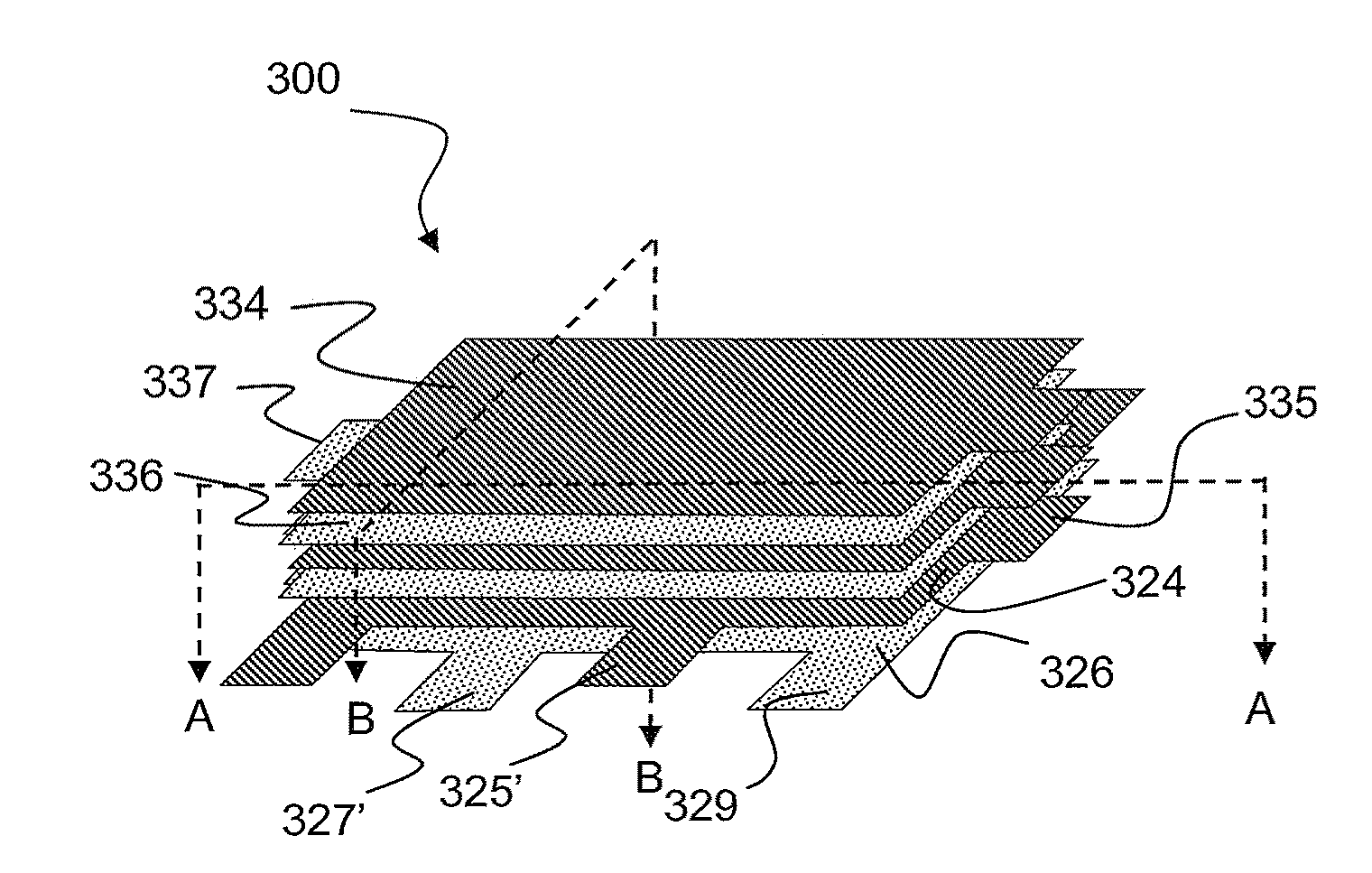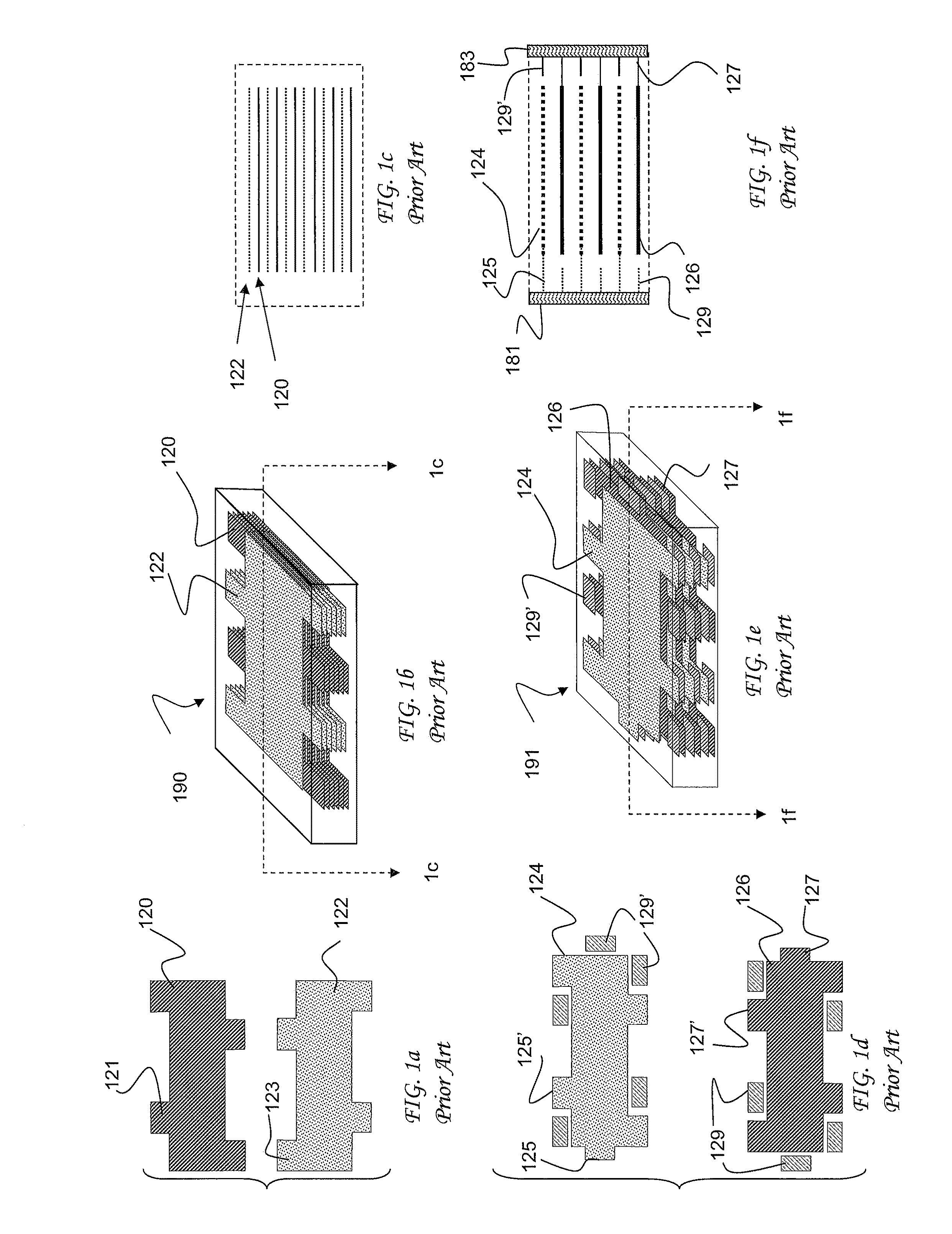Controlled esr low inductance capacitor
a low-inductance capacitor and capacitor technology, applied in the direction of fixed capacitors, stacked capacitors, fixed capacitor details, etc., can solve the problems of generating unacceptable voltage spikes, needing to reduce inductance becomes a serious limitation, and the potential drawback of decreasing esr may also arise, so as to reduce the overall device inductance, improve current cancellation, and increase the current path length
- Summary
- Abstract
- Description
- Claims
- Application Information
AI Technical Summary
Benefits of technology
Problems solved by technology
Method used
Image
Examples
embodiment 200
[0080]FIG. 2c provides two cross-sectional views of first exemplary capacitor embodiment 200 namely, a longitudinal cross-section on the left and a transverse cross section on the right. From the longitudinal cross-section of FIG. 2c, it is apparent that each of the first and second electrodes 224 and 226 (i.e., mother electrodes) as well as third and fourth electrodes 234 and 236 (i.e., daughter electrodes) extends to and is exposed along one of two end surfaces by an internal-connection end tab 235, 237, 225 or 227. From the transverse cross-sectional view of FIG. 2c, it is apparent that only the first and second electrodes 224 and 226 (i.e., mother electrodes) include directly connected tabs (225′ and 227′) that extend to and are exposed along the two side surfaces of the device 200. Areas 240 in the respective cross-sectional views generally correspond to the dielectric material provided between the various electrode layers and anchor tabs.
[0081]It should be appreciated that dif...
exemplary embodiment 200
[0087]A notable present aspect of the first exemplary embodiment 200 of FIGS. 2a-2f is that the interdigitated electrode tabs 225′, 227′ (i.e., circuit-connection tabs) electrically connect the side terminations (circuit-connection terminals) only to the bottom two electrode surfaces (the pair of first and second mother electrodes 224 and 226). Since the inductance is primarily determined by the closest planes to the circuit board, such device 200 is thus a low inductance capacitor. External circuit connection is only made directly to the lower two layers, first and second electrodes 224 and 226). The rest of the electrode stack, consisting of electrode designs 234 and 236, are connected together in parallel (via the end terminations 281 and 283) but are only connected in series to the ends of electrodes 224 and 226, respectively. Electrical connection is only made internally to the third and fourth electrodes 234 and 236. By providing a large number of pairs of third and fourth (da...
exemplary embodiment 500
[0104]Referring now to FIGS. 5a through 5h, a third exemplary embodiment 500 of the present technology provides not only low inductance features, but also a way to add controlled ESR into a unitary MLC device. More particularly, and similar to the embodiments 200 and 300 described before, such exemplary device 500 utilizes not only two different electrode configurations, but four two mother electrode and two daughter electrode configurations. First and second electrodes 520 and 522 are similar in many respects to the electrodes 420 and 422 of FIGS. 4a-4c.
[0105]Referring more particularly to FIG. 5a, first electrode 520 includes a substantially rectangular main portion and two tabs 521, 521′ that extend from a longer side of the electrode 520. Second electrode 522 includes a substantially rectangular main portion and two tabs 523, 523′ that extend from the same longer side of the electrode 522 (as do tabs 521, 521′ extend from electrode 520). First electrode 520 and second electrode...
PUM
 Login to View More
Login to View More Abstract
Description
Claims
Application Information
 Login to View More
Login to View More - R&D
- Intellectual Property
- Life Sciences
- Materials
- Tech Scout
- Unparalleled Data Quality
- Higher Quality Content
- 60% Fewer Hallucinations
Browse by: Latest US Patents, China's latest patents, Technical Efficacy Thesaurus, Application Domain, Technology Topic, Popular Technical Reports.
© 2025 PatSnap. All rights reserved.Legal|Privacy policy|Modern Slavery Act Transparency Statement|Sitemap|About US| Contact US: help@patsnap.com



